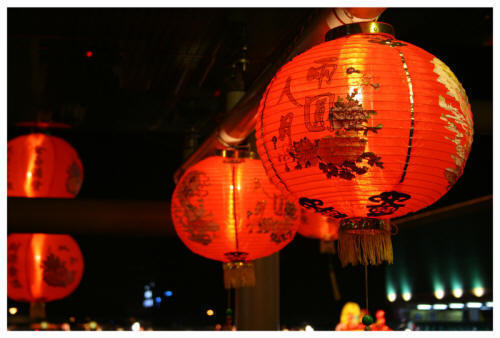Chinese Culture >> Chinese Society Traditions >> Lantern Festival
Lantern Festival
Every year on the fifteenth day of the first lunar month, Chinese people celebrate the traditional Lantern Festival.
 The
first month of the lunar calendar is known as the "yuan" month, and the ancient
Chinese people call nights "xiao," so the fifteenth day of the first lunar month
is known as the "Yuan Xiao Festival" (also known as the Lantern Festival). That
night is the first full moon of the year and that is also the first night when
spring returns to the great earth. From historical recordings, it is known that
people in the Western Han Dynasty (206 to 6 BC)
were already celebrating the "Lantern Festival."
The
first month of the lunar calendar is known as the "yuan" month, and the ancient
Chinese people call nights "xiao," so the fifteenth day of the first lunar month
is known as the "Yuan Xiao Festival" (also known as the Lantern Festival). That
night is the first full moon of the year and that is also the first night when
spring returns to the great earth. From historical recordings, it is known that
people in the Western Han Dynasty (206 to 6 BC)
were already celebrating the "Lantern Festival."
During the Lantern Festival, people light lanterns in different colors and
designs for others to admire. The Chinese Lantern Festival is the last day of
the traditional
Chinese New Year
celebration period.
The Lantern Festival is also known as the Little New Year
since it marks the end of the series of celebrations starting from the
Chinese New Year.
Koreans celebrate this festival as the Daeboreum. During the Lantern Festival,
children go out at night carrying bright lanterns. In ancient times, the
lanterns were fairly simple, for only the emperor and noblemen had large ornate
ones; in modern times, lanterns have been embellished with many complex designs.
For example, lanterns are now often made in shapes of animals.
Traditionally, the date once served as a day for love and matchmaking. It was
one of the few nights in ancient times without a strict curfew. Young people
were chaperoned in the streets in hopes of finding love. Matchmakers acted
busily in hopes of pairing couples. The brightest lanterns were symbolic of good
luck and hope.
Those who do not carry lanterns often enjoy watching informal lantern parades.
Other popular activities at this festival include eating tangyuan a sweet
glutinous rice dumpling served in a sugary soup, and guessing lantern riddles,
often messages of love.

